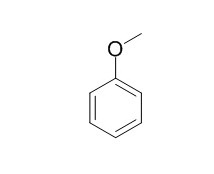Anisole
Anisole is a flavouring agent that is a precursor to perfumes, insect pheromones, and pharmaceuticals. It is also a new dopant for atmospheric pressure photoionization mass spectrometry of low proton affinity, low ionization energy compounds.
Inquire / Order:
manager@chemfaces.com
Technical Inquiries:
service@chemfaces.com
Tel:
+86-27-84237783
Fax:
+86-27-84254680
Address:
1 Building, No. 83, CheCheng Rd., Wuhan Economic and Technological Development Zone, Wuhan, Hubei 430056, PRC
Providing storage is as stated on the product vial and the vial is kept tightly sealed, the product can be stored for up to
24 months(2-8C).
Wherever possible, you should prepare and use solutions on the same day. However, if you need to make up stock solutions in advance, we recommend that you store the solution as aliquots in tightly sealed vials at -20C. Generally, these will be useable for up to two weeks. Before use, and prior to opening the vial we recommend that you allow your product to equilibrate to room temperature for at least 1 hour.
Need more advice on solubility, usage and handling? Please email to: service@chemfaces.com
The packaging of the product may have turned upside down during transportation, resulting in the natural compounds adhering to the neck or cap of the vial. take the vial out of its packaging and gently shake to let the compounds fall to the bottom of the vial. for liquid products, centrifuge at 200-500 RPM to gather the liquid at the bottom of the vial. try to avoid loss or contamination during handling.
J Food Compos Anal2017, 62:197-204
Appl Microbiol Biotechnol.2018, 102(12):5105-5120
J Biochem Mol Toxicol.2022, e23211.
Functional Ecology2020, doi: 10.1111.
Biochem Pharmacol.2023, 211:115502.
Pharmacol Res.2020, 161:105205.
ACS Omega.2024, 9(12):14356-14367.
J of Applied Pharmaceutical Science2020, 10(1):077-082
Brain Res Bull.2024, 218:111103.
J Pharm Biomed Anal.2024, 241:115990.
Related and Featured Products
Applied Catalysis Volume 49, Issue 1, 3 April 1989, Pages 109–123
Design of synthetic zeolites as catalysts in organic reactions: Acylation of Anisole by Acyl Chlorides or Carboxylic Acids Over Acid Zeolites[Reference:
WebLink]
METHODS AND RESULTS:
Acylation of Anisole with phenylacetyl and phenylpropanoyl chlorides and phenylacetic and 3-phenylpropionic acids was carried out in a batch reactor at 50–115°C over a series of zeolites Y at 21, 50 and 100% Na+ exchange, with a framework Si-to-Al ratio from 9 to 24 and on HZSM-5 and H-β zeolites. The products observed were the corresponding acids and the para-substituted aryl ketones. Only trace amounts of the ortho isomers could be detected, and phenol and cresols were absent from the reaction mixtures. When phenylpropanoyl chloride and phenylpropionic acid were used as the acylating agent, 1-indanone was also formed. From the relative adsorption constants of phenylacetyl chloride and Anisole on HY-100 zeolite, and the absence of any Anisole demethylation and rearrangement products, it was concluded that the interaction of the acid sites with the Anisole oxygen must not be very strong. On the other hand, the influence of the level of Na+ exchange on the initial rate of formation of 1-(4-methoxyphenyl)-2-phenyl-phenylethanone shows that the activity of the catalyst is independent of its acid strength distribution. This was confirmed by studying the influence of the framework Si-to-Al ratio on the turnover numbers (TON). The relatively small TON differences could be related to the hydrophobicity of the samples. By using zeolites with different pore size and configuration it was observed that while Y and 5β zeolites show similar behaviour, the medium-pore ZSM-5 fails to catalyse the acylation of p-cresol with phenylacetic acid for steric reasons.
CONCLUSIONS:
Finally, it was observed that zeolites give a much higher ratio of inter- to intramolecular acylation than a typical Lewis acid such as AlCl3.
Rapid Commun Mass Spectrom. 2004;18(7):808-15.
Anisole, a new dopant for atmospheric pressure photoionization mass spectrometry of low proton affinity, low ionization energy compounds.[Pubmed:
15052564 ]
Atmospheric pressure photoionization (APPI) is a novel method of ionization in liquid chromatography/mass spectrometry (LC/MS).
METHODS AND RESULTS:
It was originally developed in order to broaden the range of LC/MS ionizable compounds towards less polar compounds that cannot be analyzed by electrospray (ESI) and atmospheric pressure chemical ionization (APCI). Studies done thus far have shown that non-polar compounds that earlier were not ionizable in LC/MS can indeed be ionized by the use of APPI. However, the best ionization efficiency for low polarity samples has been achieved with low proton affinity (PA) solvents that are not suitable in reversed-phase LC (RP-LC).
CONCLUSIONS:
Here it is demonstrated that the signals for analytes with low proton affinities in acetonitrile can be increased 100-fold by using Anisole as the dopant for APPI, which takes the sensitivity to the same level achieved in the analysis of high PA analytes.



